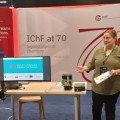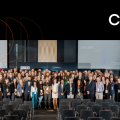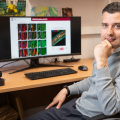Chemists from Warsaw congratulate the furthest away chemical laboratory
Reading time: about 3 minuts

On January 25, 2004 the exploration rover Opportunity landed on Mars. It was to operate for only a few months, it has been examining the geological history of the Red Planet to this day. On the 13th anniversary of its landing chemists from the Institute of Physical Chemistry of the Polish Academy of Sciences in Warsaw congratulate the teams of scientists and engineers from NASA and the JPL research centre, responsible for the implementation of this unique mission.
In January 2004, when Opportunity landed on the Martian plain of Meridiani Planum, everyone expected a mission lasting at most a few months. Thirteen years later, Opportunity, powered by solar panels cleaned from time to time by Martian dust devils and wind, is still moving around the hills of the crater Endeavour, regularly providing valuable information about the environment of the Red Planet and its geological and chemical past and present. On the successive anniversary of its landing, on the day it starts its fourteenth earth-year of penetration of the surface of Mars, chemists from the Institute of Physical Chemistry of the Polish Academy of Sciences (IPC PAS) in Warsaw congratulate the teams of scientists and engineers from NASA and the Jet Propulsion Laboratory research centre in Pasadena, responsible for the course of this outstanding mission.
“At the Institute we have been involved in the detection of chemical compounds for many years, both directly, with the aid of a variety of carefully designed sensors, as well as remotely, in deep space. We are well aware of the scale of the challenges faced here. Carrying out geochemical research in such a hostile environment as Mars, for so many years, is an unprecedented achievement, worthy of the highest recognition,” says Prof. Robert Holyst (IPC PAS).
Apart from the Curiosity rover, which landed on Mars in 2012 and is powered by a radioisotope thermoelectric generator, Opportunity is the farthest chemical laboratory operating on the surface of the planet. It is thanks to research conducted by Opportunity that the world of science has obtained evidence of the presence of liquid water on the surface of ancient Mars. The rover has also become the first extraterrestrial meteorite hunter: it found its first meteorite (iron) back in 2005.
In order to increase public interest in the success of Opportunity's mission and the surprisingly long period of its duration, the congratulations are accompanied by... a short comic written and designed by journalist and science editor Jarek Chrostowski and prepared by Magda Switon from the company Dual Color which deals with scientific illustrations (the comic can be downloaded in print-resolution from the press service of the IPC PAS or the dualcolor.pl website).
The Institute of Physical Chemistry of the Polish Academy of Sciences deals with interdisciplinary research at the interface of chemistry, physics and biology. One of the most important areas of its activity is chemical detectors designed for the detection of trace amounts of chemical compounds (composed of both relatively simple to very complex molecules), for applications in industry and medicine.
- Author: prof. dr hab. Robert Hołyst
- Date: 25.01.2017





